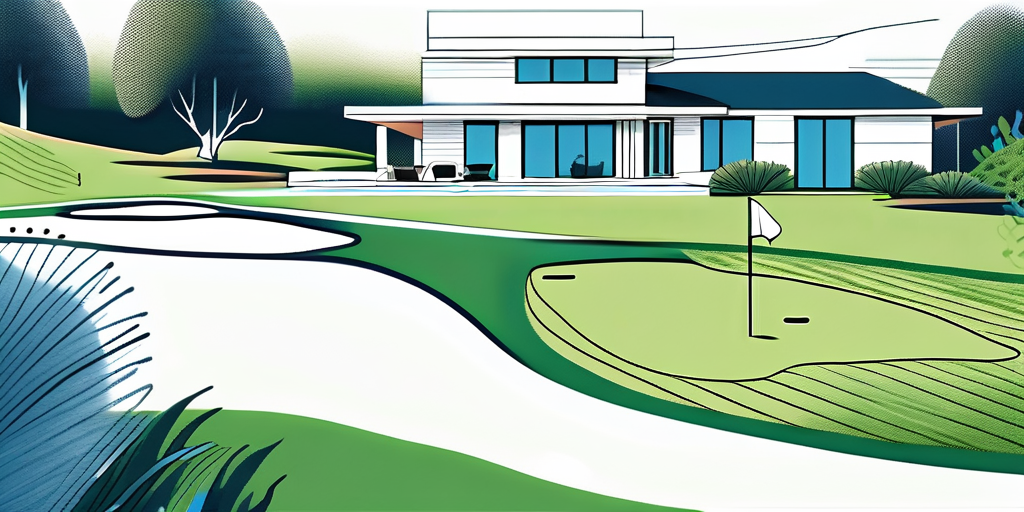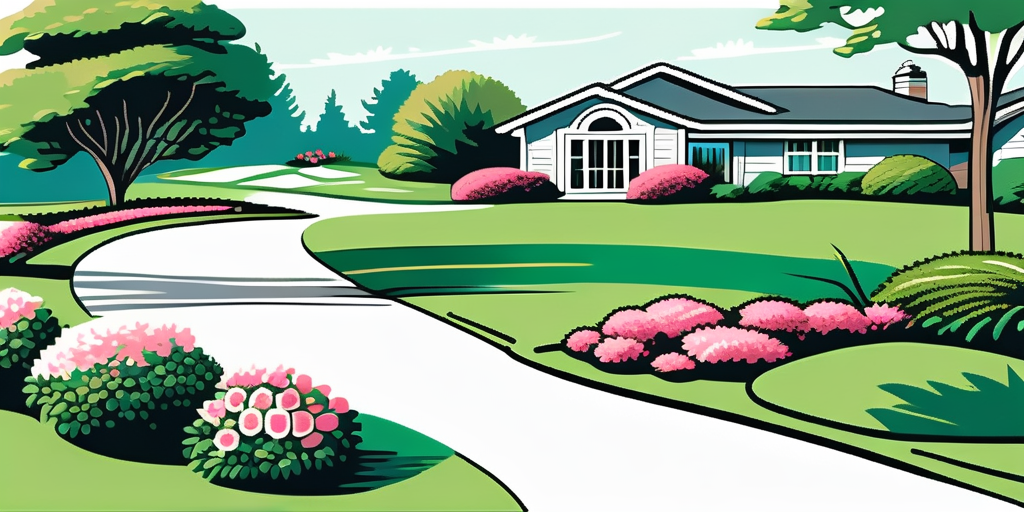
Are you considering moving to a golf course community or investing in a golf home? You're in the right place! This guide will walk you through everything you need to know about buying golf homes near golf courses. From understanding the lifestyle to navigating the buying process, we cover it all in detail.
Golf homes offer a unique appeal that attracts both avid players and those who enjoy the serene ambiance of golf-course living. The combination of stunning landscapes, recreational opportunities, and community living creates an environment that's hard to beat.
Living on a golf course isn't just about playing golf. It’s about a lifestyle! Imagine sipping your morning coffee while taking in breathtaking views of greens and fairways. Many golf communities provide amenities such as clubhouses, fitness centers, and swimming pools that amplify the leisure experience.
Moreover, there's a strong sense of community in these neighborhoods. Residents often share similar interests, which can lead to making lasting friendships. There are social events, tournaments, and activities to keep the spirit of camaraderie alive. For instance, many communities host seasonal events like holiday parties, summer barbecues, and themed golf tournaments that encourage participation and foster connections among neighbors. The shared love for the sport and the lifestyle creates a vibrant social fabric, making it easy to forge bonds over shared experiences.
Even if you're not an avid golfer, living near a golf course has its advantages. These areas typically boast elegant landscape designs, less traffic, and an overall tranquil atmosphere. Academic institutions often gravitate towards these regions, making them ideal family-friendly locations.
In addition, golf courses tend to maintain high property values. This makes homes in these neighborhoods not only desirable places to live but smart investment choices as well. The consistent upkeep of the courses and surrounding areas contributes to a sense of pride among residents, while the availability of outdoor activities, such as walking trails and picnic areas, enhances the quality of life. Furthermore, many golf communities are strategically located near shopping centers, restaurants, and cultural attractions, ensuring that residents have easy access to both leisure and convenience, making everyday living a delightful experience.
Before diving into the real estate market, there are several important considerations to keep in mind to ensure you find the perfect golf home for your needs.

Location is paramount in real estate, and golf homes are no exception. Proximity to major highways, shopping centers, and schools can significantly impact your day-to-day life. Additionally, consider how far you’re willing to drive to access basic amenities and entertainment options.
Check out the community's layout—are the homes situated conveniently near the club facilities? Or will you have to trek to reach the next tee? Accessibility not only affects convenience but also long-term satisfaction with your purchase. Moreover, think about the surrounding environment; is the neighborhood peaceful and well-maintained? Are there parks, walking trails, or other recreational areas nearby that can enhance your lifestyle? A community that offers a blend of leisure and convenience can greatly enrich your living experience.
Understanding the market trends in golf course communities is crucial. Ask yourself: how does the property value compare to surrounding neighborhoods? Consulting with a knowledgeable real estate agent who specializes in golf homes can provide valuable insights into local market conditions.
Additionally, consider that market demand can fluctuate. Think about the resale potential before making a purchase. While you might find your dream home now, it's also wise to consider how it might hold its value over time. Investigate the history of property values in the area—have they been stable, or have they seen significant ups and downs? This information can help you make a more informed decision and potentially avoid future financial pitfalls.
Many golf communities come with membership rewards but also with responsibilities. Memberships can range from casual access to exclusive privileges at club facilities. Investigate the associated fees, as they can add up over time.
Understand what’s included in your membership: can you bring guests? Are there additional fees for amenities, like dining or event access? Clarifying any ambiguities upfront ensures there are no surprises after your purchase. Furthermore, consider the social aspect of membership; many golf communities host events, tournaments, and gatherings that can foster friendships and a sense of belonging. Engaging with fellow residents can enhance your golfing experience and provide a supportive network, making your new home feel even more welcoming.
With numerous options available, it's essential to know the types of golf homes to help you narrow down your choices. Each has its unique features and pricing, suited to different lifestyles and budgets.
Luxury golf homes often boast top-notch amenities and architectural elegance. From sprawling estates with private pools to homes that overlook pristine golf courses, these properties offer comfort with a dash of opulence.
While these homes can require considerable investment, they often feature premium materials, cutting-edge technology, and expansive living spaces designed for entertaining guests. If luxury is what you seek, look for properties that provide both comfort and style.
In addition to their lavish interiors, many luxury golf homes are located within exclusive gated communities that offer additional security and privacy. Residents often enjoy access to private golf clubs, fine dining establishments, and wellness facilities, enhancing the overall lifestyle experience. Moreover, these communities frequently host social events and activities, fostering a sense of camaraderie among residents who share a passion for the sport.
Not all golf homes carry a hefty price tag. Affordable options are available for those wanting the golf-course lifestyle without breaking the bank. These homes provide essential amenities in a beautiful setting while remaining budget-friendly.
Smaller homes, condos, or townhouses within golf course communities can offer a viable solution for first-time buyers or retirees seeking to downsize. They often still grant access to community amenities without the luxury pricing, making them a smart choice for many buyers.
Additionally, many affordable golf homes come with the added benefit of proximity to local attractions and services, such as shopping centers, parks, and recreational facilities. This makes them ideal for families or individuals who value convenience and community engagement. Furthermore, these homes can often be found in vibrant neighborhoods where residents can enjoy a variety of social activities, from golf tournaments to community barbecues, ensuring that the golf lifestyle is accessible to all, regardless of budget.
Now that you're loaded with information about what to look for, let’s talk about how to navigate the buying process successfully.

Choosing the right real estate agent is crucial. An agent who specializes in golf communities will understand the nuances of this unique market. They can help you locate properties that suit your requirements and negotiate deals on your behalf.
Don’t hesitate to ask for referrals from friends or family or check online reviews to find someone reputable. A qualified real estate agent will be instrumental in guiding you through the process, from property viewings to closing deals. Additionally, a knowledgeable agent will be familiar with the various golf communities in your area, providing insights into the amenities, social events, and overall lifestyle that each community offers. This expertise can be invaluable, especially if you're new to the area or the golf lifestyle.
Financing a golf home can differ from typical home purchases. Many lenders have specific criteria tailored for these properties, including consideration for homeowners association (HOA) fees and membership costs.
Shop around for mortgage options, and don’t hesitate to consult financial advisors to assist you in securing the best rate and terms for your investment. Being informed will empower you in the long run. Furthermore, it’s essential to factor in the potential for property appreciation in golf communities, as these homes often hold their value well due to the desirability of their locations. Understanding the market trends and future developments in the area can help you make a more informed decision about your financing options and long-term investment strategy.
Once you've purchased your golf home, it’s essential to keep your property in tip-top shape. Regular maintenance can ensure your investment continues to yield benefits long into the future.

Many golf course communities have homeowners associations (HOAs) that set rules and regulations for maintaining the community’s aesthetic appeal and property values. Familiarize yourself with these guidelines—after all, they can dictate everything from landscaping to exterior modifications.
Following the HOA’s rules not only helps maintain harmony within the community but also avoids any potential penalties. Regular communication with the HOA can foster positive relationships, keeping you in the loop about any community events or adjustments to rules. Additionally, participating in HOA meetings can provide insights into future developments in the area, and give you a voice in decisions that affect your community.
Maintaining your golf home’s landscaping is crucial, especially if you’re located on or near a golf course. Regulating yard care, adhering to HOA standards, and ensuring proper irrigation can keep your home looking beautiful year-round.
Additionally, considering professional landscaping services can help you manage upkeep and design an outdoor space that complements your home. It’s an investment that can enhance your property’s value and attractiveness. Incorporating native plants into your landscaping not only reduces maintenance but also supports local wildlife and promotes sustainability. Furthermore, installing features like a rain garden or permeable paving can improve drainage and minimize water runoff, which is particularly beneficial in areas prone to heavy rainfall.
Moreover, regular inspections of your property’s exterior, including the roof, gutters, and siding, can prevent more significant issues down the line. Keeping an eye on wear and tear will allow you to address problems early, saving you time and money in the long run. Seasonal maintenance tasks, such as winterizing your home or preparing your garden for spring, are also vital to ensure your property remains in excellent condition throughout the year.